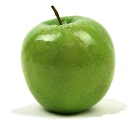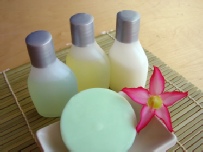



Helping you make healthy choices for you and your family

How Safe Are The Products In Your Home?
Carcinogens absorbed through the skin bypass the liver and reach the general blood circulation without this protective detoxification. So until these toxic ingredients are properly regulated or warnings placed on the products’ labels letting us know of the cancer risks, it would be best to avoid products with these toxic ingredients.
Time to protect babies from dangerous products
From shortly after birth, mothers tenderly wash and pamper their infants with a wide range of baby products. It is hard to believe that even most baby products like soaps, bubble bath, shampoos, lotions, and dusting powders, some of which are used several times daily, contain a witch's brew of dangerous ingredients. Many of these ingredients are highly toxic to which infants are about 100 times more sensitive than adults.
How safe are the products in your home?
Check the following products in your home and see.
Time to protect babies from dangerous products
From shortly after birth, mothers tenderly wash and pamper their infants with a wide range of baby products. It is hard to believe that even most baby products like soaps, bubble bath, shampoos, lotions, and dusting powders, some of which are used several times daily, contain a witch's brew of dangerous ingredients. Many of these ingredients are highly toxic to which infants are about 100 times more sensitive than adults.
How safe are the products in your home?
Check the following products in your home and see.
Typical products used daily by infants and children, men and women: Shampoo, conditioner, hair gel, hair spray, soap, shower gel, bubble bath, talcum powder, deodorant, toothpaste, mouthwash, body lotion, facial moisturisers and cleansers and cosmetics like: blusher, eye shadow, powder, foundation, lipstick and mascara.
Here are a few of the worst offenders of the thousands of toxic chemicals and potentially harmful ingredients used in personal and skin care products as above. Many of these chemicals have more than one effect; some are suspected carcinogens, as well as being toxins, contaminates, skin irritants, hormone disruptors, poisons, etc:
# Alcohol/ Ethyl Alcohol: A colourless, volatile, flammable liquid produced by the fermentation of yeast and carbohydrates. Alcohol is used frequently as a solvent and is also found in mouthwashes and medicine. Limited evidence has shown associations between long-term use of high alcohol (more than 25%) mouthwashes and risks of mouth and throat cancers.
# Alpha Hydroxy Acid (AHA): An organic acid produced by anaerobic respiration. They are often found in products claiming to reduce wrinkles or the signs of aging, and improve the overall look and feel of the skin. Skin care products containing AHA exfoliate not only damaged skin cells, but the skin's protective barrier as well.
# Aluminium: A metallic element used extensively in the manufacture of aircraft components, prosthetic devises and as an ingredient in antiperspirants, deodorants, antacids and antiseptics. Aluminium is highly toxic to the body especially the central nervous system and is linked with Alzheimer's disease.
# Animal Fat (Tallow): A type of animal tissue made up of oily solids that are water-insoluble esters of glycerol with fatty acids. Animal fats and lye are the chief ingredients in a bar of soap.
# Bentonite: Porous clay that expands to many times its dry volume as it absorbs water. Used to suffocate forest fires. May provide a suffocating barrier to the skin. Bentonite is commonly found in many cosmetic foundations.
# Collagen: Makes skin feel artificially smooth. An insoluble fibrous protein that is too large to penetrate the skin but may suffocate skin. Collagen found in most skin care products is derived from animal skins and ground up chicken feet.
# Diethanolamine (DEA): A chemical that is used as a wetting agent in shampoos, lotions, creams, hair dyes and other cosmetics. DEA is used widely because it provides a rich lather in shampoos and keeps a favourable consistency in lotions and creams. DEA by itself is not harmful but whilst sitting on the shop shelves or in your cabinet at home, DEA can react with other ingredients in the cosmetic formula to form an extremely potent carcinogen called nitrosodiethanolamine (NDEA). NDEA is readily absorbed through the skin and has been linked with stomach, esophagus, liver and bladder cancers.
# Dioxins: A potentially carcinogenic by-product that results from the process used to bleach paper at paper mills. 1,4-dioxane is a potent carcinogen itself and is related to dioxin,the most toxic chemical known. It is a POTENT hormone disruptor. Did you know? The average human male sperm count dropped 50% between 1938 and 1990.
# Elastin of High-molecular Weight: A protein similar to collagen that is the main component of elastic fibres. Elastin is also derived from animal sources. May coat the skin inhibiting proper function. Found in shampoo, hair conditioner, skin cream and lotion.
# Fluoride: Cumulative poison. Classified as a contaminant by the USEPA and is on Canadian hotlist. Found mainly in toothpaste and mouthwash. It is added to some water supplies and given to babies as drops. Fluoride is toxic to the body.
# Fluorocarbons: A colourless, non-flammable gas or liquid. Fluorocarbons are commonly used as a propellant in hairsprays.
# Formaldehyde: Suspected carcinogen and neurotoxin.. Banned in some countries. When combined with water, formaldehyde is used as a disinfectant, fixative or preservative. Formaldehyde is found in many cosmetic products, and conventional nail care systems and sometimes used in baby shampoo, bubble bath, deodorants, perfume, cologne, hair dye, mouthwash, toothpaste, hair spray and sometimes used as a filler in vaccines. The following information is taken from a Material Safety Data Sheet (MSDS) which, by law, must be supplied to anyone who uses any chemical product in the workplace. The MSDS for formaldehyde warns:
"Suspected carcinogen; May be fatal if inhaled, swallowed, or absorbed through skin; causes burns; inhalation can cause spasms, edema (fluid buildup) of the larynx and bronchi, and chemical pneumonitis; extremely destructive to tissue of the mucous membrane." The following ingredients contain formaldehyde, and may release formaldehyde, or may break down into formaldehyde: (The "Safe Shopper's Bible", by David Steinman & Samuel S. Epstein, M.D.)
# 2-bromo-2-nitropropane-1,3-diol: A preservative. Ittitant for some individuals. Can cause contact allergies and dermatitis. It is capable of interacting with amine-ingredients, forming carcinogens.
# Diazolidinyl urea: A preservative which can cause dermatitis.
# DMDM hydantoin: A preservative which can cause dermatitis.
# Imidazolidinyl urea: A preservative which can cause dermatitis.
# Quaternium 15: A preservative which can cause dermatitis. Has been linked to serious hypersensitivity and anaphylactic shock.
# Fragrances: In perfumes, toiletries, cleaning products, and air fresheners. Many are very toxic and have been recognised as a considerable source of indoor air pollution. They absorb through the lungs and skin into the blood stream and can cause atherosclerosis, cancer, neurological and phychiatric symptoms, allergies and many other health problems. The U.S. National Institute of Occupational Safety and Health has reported that the fragrance industry uses up to 3,000 ingredients, mainly synthetic, some 900 of which were identified as toxic. However the industry is not required to disclose any information on fragrance ingredients due to trade secrecy consideration. The FDA supports this non-disclosure on the grounds that " consumers are not adversely affected and should not be deprived of the enjoyment" of these products.
# Glycerin: A syrupy liquid that is chemically produced by combining water and fat. Glycerin is used as a solvent and plasticiser. Found mainly in moisturizers and lotions. Unless the humidity of air is over 65%, glycerin draws moisture from the lower layers of the skin and holds it on the surface, so drying the skin from the inside out.
# Kaoline: A fine white clay used in making porcelain. Similar to Bentonite used to suffocate forest fires. May provide a suffocating barrier to the skin. Kaoline and Bentonite are commonly found in many cosmetic foundations.
# Lanolin: A fatty substance extracted from wool, most samples of which are contaminated with DDT-like pesticides. Lanolin is frequently found in cosmetics and lotions.
# Lye: A highly concentrated watery solution of sodium hydroxide or potassium hydroxide. Found in bar soaps, may corrode or dry out skin.
# Mineral Oil: A derivative of crude oil (petroleum) that is used in industry as a cutting fluid and lubricating oil. Found in liquid foundations, blush, skin creams and baby oil. Mineral oil forms an oily film over the skin to lock in moisture, clogs pores and locks in toxins and wastes, suffocates and dries out skin.
# PEG: (polyethylene glycols or polymers of ethylene oxide).Can be contaminated with 1.4 dioxane of which is extremely toxic and carcinogenic. Peg compounds can also be contaminated with ethylene oxide, lead and arsenic.
# Petrolatum: A petroleum based grease that is used industrially as a grease component. It suffocates skin, clogs pores, traps toxins inside.
# Propylene Glycol: Extremely toxic and carcinogenic. A cosmetic form of mineral oil found in automatic brake and hydraulic fluid and industrial antifreeze. It prevents things from drying out, found in deodorants, shampoos, conditioners, lotions, shaving gels. Material Safety Data Sheet states:
* implicated in contact dermatitis, kidney damage and liver abnormalities
* can inhibit skin cell growth in human tests
* can damage cell membranes causing rashes, dry skin and surface damage
# Sodium Lauryl Sulphate (SLS): Highly toxic. An anionic surfactant used in cosmetics and industrial chemicals as a cleansing agent. Used as a thickener and foaming agent in shampoos, toothpastes, and cleansers, and as a wetting agent in garage floor cleaners, engine degreasers, and auto cleaning products. Journal of American College of Toxicology (Volume 2, No. 7, 1983):
* corrodes hair follicles and impairs ability to grow hair, may cause hair to fall out.
* may form Nitrosamines when interacts with nitrogen bearing ingredients.
* builds up in the heart, liver, lungs and brain from skin contact; may cause damage to these organs.
* denatures protein--impairs proper structural formation of young eyes.
* can damage immune system.
# Saccharin: Carcinogenic. An artificial sweetener. Found in many children's soft drinks and medicines, some toothpastes. Saccharin is used frequently in products that are sugar free.
# Triethanolamine (TEA): Eye and skin irritant. Used in some liquid all-purpose cleaning products and other household cleaning products, shampoos, makeup, and hand and body lotions. Can react with nitrites which are added as undisclosed preservatives to some products to form carcinogenic nitrosamines. Nitrosamines are on the NIH hazard list.
# Talc / Talcum Powder: Carcinogenic. Should not be used on babies. Exposing children to this carcinogen is unnecessary and dangerous. Also found in blusher, feminine powders.
* Talc particles can cause tumours in human ovaries and lungs.
* American Journal of Epidemiology: 60% increase risk of ovarian cancer when used in genital areas and 90% increase risk of ovarian cancer when used in feminine deodorant sprays
* Ovarian cancer is one of the most lethal cancers, striking over some 25,000 and killing 14,000 women, annually in the U.S. It is the fourth highest women's cancer death rate in the U.S. Over 60% of ovarian cancer victims die within five years of diagnosis.
References:
# "Unreasonable Risk", by Samuel S. Epstein, M.D.
# "Safe Shopper's Bible", by David Steinman & Samuel S. Epstein, M.D
# "What's Really in your basket", by Bill Statham.
# The Cancer Prevention Coalition
# “Cosmetics Unmasked”, by Dr Stephen and Gina Antczak
Here are a few of the worst offenders of the thousands of toxic chemicals and potentially harmful ingredients used in personal and skin care products as above. Many of these chemicals have more than one effect; some are suspected carcinogens, as well as being toxins, contaminates, skin irritants, hormone disruptors, poisons, etc:
# Alcohol/ Ethyl Alcohol: A colourless, volatile, flammable liquid produced by the fermentation of yeast and carbohydrates. Alcohol is used frequently as a solvent and is also found in mouthwashes and medicine. Limited evidence has shown associations between long-
# Alpha Hydroxy Acid (AHA): An organic acid produced by anaerobic respiration. They are often found in products claiming to reduce wrinkles or the signs of aging, and improve the overall look and feel of the skin. Skin care products containing AHA exfoliate not only damaged skin cells, but the skin's protective barrier as well.
# Aluminium: A metallic element used extensively in the manufacture of aircraft components, prosthetic devises and as an ingredient in antiperspirants, deodorants, antacids and antiseptics. Aluminium is highly toxic to the body especially the central nervous system and is linked with Alzheimer's disease.
# Animal Fat (Tallow): A type of animal tissue made up of oily solids that are water-
# Bentonite: Porous clay that expands to many times its dry volume as it absorbs water. Used to suffocate forest fires. May provide a suffocating barrier to the skin. Bentonite is commonly found in many cosmetic foundations.
# Collagen: Makes skin feel artificially smooth. An insoluble fibrous protein that is too large to penetrate the skin but may suffocate skin. Collagen found in most skin care products is derived from animal skins and ground up chicken feet.
# Diethanolamine (DEA): A chemical that is used as a wetting agent in shampoos, lotions, creams, hair dyes and other cosmetics. DEA is used widely because it provides a rich lather in shampoos and keeps a favourable consistency in lotions and creams. DEA by itself is not harmful but whilst sitting on the shop shelves or in your cabinet at home, DEA can react with other ingredients in the cosmetic formula to form an extremely potent carcinogen called nitrosodiethanolamine (NDEA). NDEA is readily absorbed through the skin and has been linked with stomach, esophagus, liver and bladder cancers.
# Dioxins: A potentially carcinogenic by-
# Elastin of High-
# Fluoride: Cumulative poison. Classified as a contaminant by the USEPA and is on Canadian hotlist. Found mainly in toothpaste and mouthwash. It is added to some water supplies and given to babies as drops. Fluoride is toxic to the body.
# Fluorocarbons: A colourless, non-
# Formaldehyde: Suspected carcinogen and neurotoxin.. Banned in some countries. When combined with water, formaldehyde is used as a disinfectant, fixative or preservative. Formaldehyde is found in many cosmetic products, and conventional nail care systems and sometimes used in baby shampoo, bubble bath, deodorants, perfume, cologne, hair dye, mouthwash, toothpaste, hair spray and sometimes used as a filler in vaccines. The following information is taken from a Material Safety Data Sheet (MSDS) which, by law, must be supplied to anyone who uses any chemical product in the workplace. The MSDS for formaldehyde warns:
"Suspected carcinogen; May be fatal if inhaled, swallowed, or absorbed through skin; causes burns; inhalation can cause spasms, edema (fluid buildup) of the larynx and bronchi, and chemical pneumonitis; extremely destructive to tissue of the mucous membrane." The following ingredients contain formaldehyde, and may release formaldehyde, or may break down into formaldehyde: (The "Safe Shopper's Bible", by David Steinman & Samuel S. Epstein, M.D.)
# 2-
# Diazolidinyl urea: A preservative which can cause dermatitis.
# DMDM hydantoin: A preservative which can cause dermatitis.
# Imidazolidinyl urea: A preservative which can cause dermatitis.
# Quaternium 15: A preservative which can cause dermatitis. Has been linked to serious hypersensitivity and anaphylactic shock.
# Fragrances: In perfumes, toiletries, cleaning products, and air fresheners. Many are very toxic and have been recognised as a considerable source of indoor air pollution. They absorb through the lungs and skin into the blood stream and can cause atherosclerosis, cancer, neurological and phychiatric symptoms, allergies and many other health problems. The U.S. National Institute of Occupational Safety and Health has reported that the fragrance industry uses up to 3,000 ingredients, mainly synthetic, some 900 of which were identified as toxic. However the industry is not required to disclose any information on fragrance ingredients due to trade secrecy consideration. The FDA supports this non-
# Glycerin: A syrupy liquid that is chemically produced by combining water and fat. Glycerin is used as a solvent and plasticiser. Found mainly in moisturizers and lotions. Unless the humidity of air is over 65%, glycerin draws moisture from the lower layers of the skin and holds it on the surface, so drying the skin from the inside out.
# Kaoline: A fine white clay used in making porcelain. Similar to Bentonite used to suffocate forest fires. May provide a suffocating barrier to the skin. Kaoline and Bentonite are commonly found in many cosmetic foundations.
# Lanolin: A fatty substance extracted from wool, most samples of which are contaminated with DDT-
# Lye: A highly concentrated watery solution of sodium hydroxide or potassium hydroxide. Found in bar soaps, may corrode or dry out skin.
# Mineral Oil: A derivative of crude oil (petroleum) that is used in industry as a cutting fluid and lubricating oil. Found in liquid foundations, blush, skin creams and baby oil. Mineral oil forms an oily film over the skin to lock in moisture, clogs pores and locks in toxins and wastes, suffocates and dries out skin.
# PEG: (polyethylene glycols or polymers of ethylene oxide).Can be contaminated with 1.4 dioxane of which is extremely toxic and carcinogenic. Peg compounds can also be contaminated with ethylene oxide, lead and arsenic.
# Petrolatum: A petroleum based grease that is used industrially as a grease component. It suffocates skin, clogs pores, traps toxins inside.
# Propylene Glycol: Extremely toxic and carcinogenic. A cosmetic form of mineral oil found in automatic brake and hydraulic fluid and industrial antifreeze. It prevents things from drying out, found in deodorants, shampoos, conditioners, lotions, shaving gels. Material Safety Data Sheet states:
* implicated in contact dermatitis, kidney damage and liver abnormalities
* can inhibit skin cell growth in human tests
* can damage cell membranes causing rashes, dry skin and surface damage
# Sodium Lauryl Sulphate (SLS): Highly toxic. An anionic surfactant used in cosmetics and industrial chemicals as a cleansing agent. Used as a thickener and foaming agent in shampoos, toothpastes, and cleansers, and as a wetting agent in garage floor cleaners, engine degreasers, and auto cleaning products. Journal of American College of Toxicology (Volume 2, No. 7, 1983):
* corrodes hair follicles and impairs ability to grow hair, may cause hair to fall out.
* may form Nitrosamines when interacts with nitrogen bearing ingredients.
* builds up in the heart, liver, lungs and brain from skin contact; may cause damage to these organs.
* denatures protein-
# Saccharin: Carcinogenic. An artificial sweetener. Found in many children's soft drinks and medicines, some toothpastes. Saccharin is used frequently in products that are sugar free.
# Triethanolamine (TEA): Eye and skin irritant. Used in some liquid all-
# Talc / Talcum Powder: Carcinogenic. Should not be used on babies. Exposing children to this carcinogen is unnecessary and dangerous. Also found in blusher, feminine powders.
* Talc particles can cause tumours in human ovaries and lungs.
* American Journal of Epidemiology: 60% increase risk of ovarian cancer when used in genital areas and 90% increase risk of ovarian cancer when used in feminine deodorant sprays
* Ovarian cancer is one of the most lethal cancers, striking over some 25,000 and killing 14,000 women, annually in the U.S. It is the fourth highest women's cancer death rate in the U.S. Over 60% of ovarian cancer victims die within five years of diagnosis.
References:
# "Unreasonable Risk", by Samuel S. Epstein, M.D.
# "Safe Shopper's Bible", by David Steinman & Samuel S. Epstein, M.D
# "What's Really in your basket", by Bill Statham.
# The Cancer Prevention Coalition
# “Cosmetics Unmasked”, by Dr Stephen and Gina Antczak
Disclaimer: The information in this article should not be regarded as medical advice. If you are receiving medical treatment or taking prescribed medication, you are advised to consult your GP or health practitioner before making any changes to your diet or lifestyle.

Cosmetic and personal care product industries worldwide are unregulated by government and are essentially self-regulating. There are no requirements for pre-market ingredients and product safety testing. While nearly all nations require ingredient labelling, which most consumers have a hard time in deciphering, not only are the labels uninformative, they are at best tokenistic. Few governments have taken even minimal regulatory action, specifically seizure or recall, against any products containing carcinogenic or otherwise hazardous ingredients, in spite of strongly supportive scientific evidence.
This virtual absence of regulation is disturbing as most people in developed countries use multiple personal care products and cosmetics, each day for a life time. This is even more alarming since the skin's role is a carrier more than a barrier and this has been well known for decades.
Carcinogens in cosmetics and personal care products pose greater risks, than does food contaminated with carcinogenic pesticides and other industrial carcinogens. Carcinogens taken in by the mouth are absorbed from the intestines into blood which then reaches the liver. Once in the liver, carcinogens can be detoxified to varying degrees by deactivating enzymes before reaching the rest of the body.
| Your Health Your Future |
| Controversial Ingredients |
| Nutritional State |
| Parent and Child |
| Microwave Ovens |
| Recommended Books |
| Skin Absorption |
| Sodium Lauryl Sulphate |
| Propylene Glycol |
| DEA, MEA, TEA |
| Chemical Calculator |
| Fluoride |
| Aspartame |
| Fluoridation |
| Water Filtration |
| Planning a Pregnancy |
| Pregnancy Care |
| Post Pregnancy Care |
| Amazon Books |
| EBooks |
| About Us |
| Health Services |
